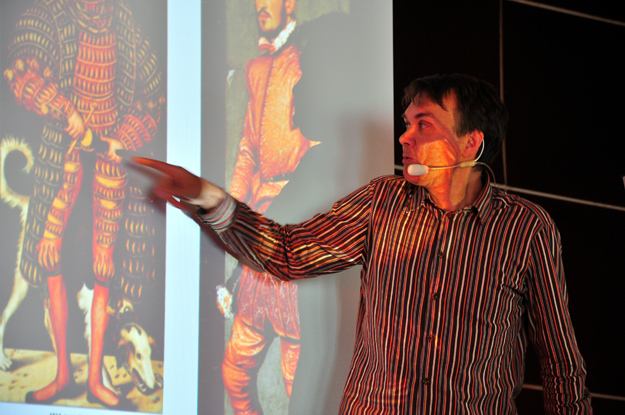At the beginning of the 2000s, Andrei Gorokhov’s book, Muzprosvet, was published. On one of the sites, the famous saxophonist Sergey Letov published his review of this publication.
He admitted that he received the book as a gift from drummer Vladimir Nelinov, with whom he participated in a production called Entre Nous in the theater "Man".
Sergei writes that this work by Andrei Gorokhov is the best work about electronic music, and it is quite possible that about art in general. The author of the critical article admits that “Muzprosvet” is read quite easily due to the fact that the writer avoids a large number of specific terms.
He also does not try to persuade anyone to share his own addictions in the field of music. After reading the book of Andrei Gorokhov, there is a desire to talk with its author, to reveal his point of view on certain issues, to argue with him.
"Muzprosvet" is a brief history of the music that replaced rock and roll, which in the seventies of the XX century began to lose its former popularity. Considering modern electronics, the author describes in every detail every style and direction: its appearance, dawn and gradual fading. In addition, Gorokhov’s book contains a large number of detailed descriptions of musical instruments and equipment that may be useful to professionals in this field. But the most important advantage of the work, according to Sergey Letov, is that its creator cites a lot of his own observations regarding the culture of our days and contemporary art in general.
Parsing Excerpts
In his article, Sergey Letov does not evaluate Andrei Gorokhov’s book, but only gives some excerpts from it and comments on them. So, he draws attention to a chapter on the genre of electronic music called Trip-Hop. One of his artistic means is the deliberate deterioration of sound quality. There are even special computer programs designed for musicians to help make a passage of a piece more noisy, illegible, and so on. As an example of such use of equipment, Andrei Gorokhov cites the creative method of Lee Perry, a musician and sound engineer who worked with such stars of the Jamaican reggae as Bob Marley and Max Romeo. Sergei, in addition to the above, says that Yegor Letov and the Civil Defense group used similar methods to create several albums, collectively known as Communism, in the eighties of the 20th century.
Pop music
In his book, Andrei Gorokhov repeatedly emphasizes that all popular electronics is nothing more than just a different kind of pop music. He urges not to confuse the works of serious composers, written for modern musical instruments, with tracks created by DJs. The author also writes that all the so-called “innovations” of pop musicians associated with the use of electronic instruments are just borrowings from academic composers such as Stockhausen, Xenakis, Subbotnik, Cage and many others.
Postmodernism
In the book "Musical Enlightenment" by Andrei Gorokhov, electronic music is considered in the context of the postmodern era in contemporary art. Creative people of today are striving not to do something new, but sometimes to change old works almost beyond recognition. This method is well seen in the work of musicians who actively use sampling, that is, compiling a track from compositions of other authors or their own. The author recalls that this principle is not new. It was used by John Lennon in the early seventies of the XX century. It is known that he wrote the song "Image" from the album of the same name, losing a passage from Beethoven's moonlight sonata on the contrary.

So the melody of the composition was born, which is recognized by many critics as the greatest hit of all time. Unlike Lennon and other prominent composers, many amateurs using the achievements of modern electronics are not able to adequately judge the quality of their works. Therefore, the do-it-yourself method often leads to the appearance of low-quality musical products.
Rare edition
The first circulation of the book "Muzprosvet" was equal to 1000 copies. It was instantly snapped up by people interested in the problems of modern music. Now books from that circulation are a rarity.
Biography of Andrei Gorokhov
The hero of this article is not only a writer, but also an artist, journalist, and radio host.
Andrei Nikolaevich Gorokhov was born in 1961. His birthplace is the capital of our country. He received a technical education. Andrei Gorokhov is a graduate of Moscow State University (Faculty of Mechanics and Mathematics) and has a degree in computer programming. In the early nineties Gorokhov emigrated to Germany, where for several years he changed a number of professions. Andrei Nikolaevich was engaged in photography, and also worked in a brewery and as a watchman in a television company. 5 years after his move, the hero of this article began working as a music columnist at the Deutsche Welle radio station. It is on the basis of materials for his programs that the aforementioned book was created. The hero of the article is familiar to listeners in two author programs: "Muzprosvet" and "Album of the week."
Browse New Electronic Music Albums
Music critic Andrei Gorokhov voiced reviews of new albums during his broadcasts. Now his comments on new records can be read on the journalist’s website.
First of all, his articles can be recommended to those who are fond of electronic music. In his short notes, the author acts as a real uncompromising critic of the Western type. He is not afraid to give negative assessments to new works of musicians working in electronic styles. For example, Andrei Gorokhov praises the first song from the Terrible two album of the 2008 American electronic trio Senk Yu.
He calls this work "real line." But the second track of this disc, as well as all subsequent numbers, the author of the review characterizes as boring, uninteresting and monotonous music. According to him, listening to these works quickly gets bored due to repeated repetitions of the same phrases.
Andrei Gorokhov's reviews differ from many other similar works, including the fact that they were written by a person who is well versed not only in electronic music, but also in other genres, not excluding classics and jazz.
For example, in the same article in the Senk Yu group album, he compares the first track from the disc of this American trio with the luminaries of the jazz master Miles Davis of the early seventies. Then the famous discoverer of jazz rock began to perform with his team music with elements of psychedelicism and space rock. With these works, the critic compares the first track from the album of American electronic musicians. This article has already mentioned the story of John Lennon's Imagine composition, which can be found in the book by Andrei Gorokhov. Enumeration of such interesting facts from the history of world music makes Gorokhov's works interesting for a wide range of readers. The same can be said about his author’s programs, which appeared on the German Wave channel in the 2000s.
Lectures about music
In addition to writing articles and books, the hero of this material is also engaged in direct communication with his audience. This happens during his lectures, which he holds in organizations such as the Center for Contemporary Art named after Sergey Kurekhin in the city of St. Petersburg.
At such meetings, Andrei Gorokhov touches on such topics as an audio recording of folk music: how works change during this process, is it possible to create something similar to masterpieces, the authors of which are considered to be people, and what is their difference from the products of popular culture? You can learn all this and much more by visiting a lecture by Andrey Gorokhov.
Ethnic music
As already mentioned, one of Andrei Gorokhov's lectures is devoted to this topic. In it, he addresses such an important question as "What can be considered genuine ethnic music?" The lecturer answers him as follows: there is no clear line between academic and folk art.

The covers of many discs with masterpieces of ethnic music do not depict villagers in folk costumes with national instruments, but professional musicians in European clothes. When looking at these images, the question involuntarily arises on the authenticity of the works performed by the collective. The author gives an example of one of the Asian countries in which, until the 20th century, in each village there was its own orchestra of folk instruments. Each locality has developed its own original performing technique. Even the same musical instruments were tuned in different villages in their own way. In the twentieth century with the advent of conservatories, professional musicians of this country became interested in the folk art of their homeland.
Big question
They began to make folklore expeditions to remote areas. After some time, employees of the Ministry of Culture decided to streamline the sound of folk orchestras. Each specific tool should now be configured only in a certain way. The works created by the people were processed by professional arrangers. It is this kind of music that was published under the guise of ethnic masterpieces. Can you call her that? This question can be answered in two ways. On the one hand, these songs and instrumental compositions were really written by the people, and on the other, they reached the listener in a very changed form.
Issue of authenticity
Similar processes occurred in other countries. For example, Egyptian intelligentsia of the 19th century, who was impressed by Verdi's famous opera Aida, considered all the folk music of her country an art for the lower layers of society.
Representatives of the elite tried their best to impose their tastes on ordinary people. As a result of this, Egyptian folk music was heavily influenced by Italian opera. Therefore, discs with recordings of Egyptian folk artists usually contain songs that are extremely difficult to call folk. As a rule, this is a kind of mixture of European chanson, opera arias and oriental melodies.
But even if you manage to find musicians playing ethnic works in their original form, it can sometimes be very difficult to make an audio recording. An integral part of some genres is live performance. When recording such works (even multi-channel), the feeling of music in space is lost.
Creativity as part of life
Another difficulty in recording folk music is that, as a rule, ethnic works are difficult to separate from the rites and traditions for which they are intended. In other circumstances, the performer cannot get the necessary mood for creativity. Andrei Gorokhov says that for the people playing music is as much a natural process as a simple everyday conversation. Therefore, it is difficult to reproduce it outside of certain circumstances.
Painting and music
In the eighties of the XX, living in the USSR, and also later during emigration, Gorokhov was engaged in abstract painting. He realized his love of art, being one of the organizers of the Isolation art fund. As part of this project, a large number of lectures on the themes of music and painting were held. Also, this organization is engaged in the organization of art exhibitions in the city of Donetsk.
Conclusion
This article provided brief biographical information about the writer, artist and radio host Andrei Gorokhov, as well as about his educational activities in the field of art. Some key points of his lectures were also outlined. In his speeches and books, Gorokhov tries in a simple way to convey to the listener his opinions about music.
The ability of Andrei Gorokhov to speak simply about complex, serious issues of art is the reason for the continuing interest of the public in his works.